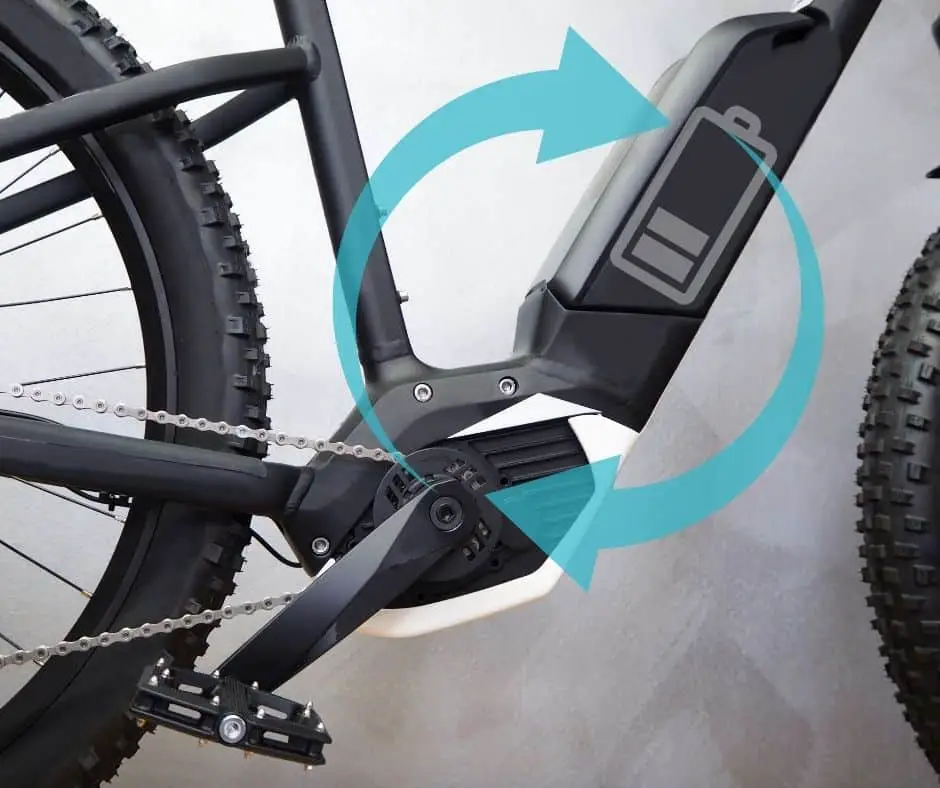Can you recharge an electric bike while pedaling? Would this allow you to keep on using your electric bike without having to stop and charge it?
Some electric bike models use regenerative braking to charge your bike while you ride it. The energy produced by your pedaling is usually lost when you brake, but it is saved and reused if you have regenerative braking. Only a small percentage (5-10%) of the energy lost by braking can be recovered to recharge the battery.
If you want to learn more about how electric bikes can charge while you pedal, continue reading.

Not All Electric Bikes Recharge While Pedaling
Although some electric bikes will charge themselves while you pedal, most will not.
Do not despair, however! Your electric bike might be a model that does recharge itself when you pedal. Alternatively, if you are interested in getting an electric bike and are wondering whether you can charge it while you pedal, consider going for a model that offers this feature. This way, you can preserve energy, help the environment, reduce wear on your brakes and extend the range of the battery by capturing some of the energy lost while braking.
What Is Regenerative Braking for Ebikes?
Regenerative braking for electric bikes is a feature found on some electric bikes. Similar to the feature on electric vehicles, when braking on an ebike some of this energy is captured and fed back into the battery. Only ebikes with direct drive hub motors are able to use regenerative braking, and only about 5-10% of energy is typically captured using regenerative braking on ebikes, with higher capture possible on more hilly terrain with more braking.
E-bikes that recharge when you pedal use technology that is known as regenerative braking. This is sometimes referred to as regenerative pedaling, but that is not the correct term.
Regenerative braking has been around for around a couple of decades. Electric bikes are not the first or only vehicles to use regenerative braking; hybrid and electric cars, as well as skateboards, have been using it.
When you brake while riding your electric bike and slow down, there is a lot of kinetic energy that can be used to charge your bike’s battery. Before regenerative braking, all of that kinetic energy was simply lost through heat of brake pads and wind resistance. However, regenerative braking allows your ebike to use that kinetic energy for something useful: powering your bike the next time you need to accelerate and extending the range of the battery.
How Effective Is Regenerative Braking on an Ebike?
How much energy can you actually preserve with regenerative braking?
There is no simple or exact answer to this question. If you are riding your electric bike over a flat surface for an extended period of time, in an area outside the city that does not have a lot of traffic, you will not preserve that much energy. Since you will not be braking much, you will not be able to use regenerative braking as much as you might like. You would likely only get up to 1% back in regenerative power.
On the other hand, if you are using your electric bike for your daily commute through the city, you could be getting a lot more out of the regenerative braking technology. In stop and go traffic, you will need to brake a lot and you could achieve regenerative braking up to 8% – 14% in the city.
If you are riding on terrain that has inclines and declines, you will likely be braking more as well, especially when going down a decline. This will allow you to get more out of your bike’s regenerative braking technology as well.
What Does Your Pedaling Have to Do With It?
If it is called regenerative braking, what does your pedaling have to do with it? Is it actually the pedaling that helps charge your bike, or is it the braking?
To understand the role pedaling plays, we have to go back to what we said before: Regenerative braking allows you to recover lost energy that you are losing when you brake. That energy is created when you pedal or transferred from the battery to the motor to get you moving and keep you moving.
When you brake, this kinetic energy created by peddaling or the motor has to go somewhere and it typically is lost to heat and wind resistance when slowing down and using the brakes. Regenerative braking captures some of the energy that would be lost and converts it back to electricity to charge the battery.
Is Regenerative Braking for Ebikes Just a Marketing Tool?
Not really. Regenerative braking is a real tool that will help you regain a certain amount of the energy you waste when braking. However, this is only possible on electric bikes that have larger motors with no gears. As such, manufacturers of electric bikes that can not use regenerative technology may claim that regenerative braking is simply a marketing hack that does not accomplish much in an effort to put it down.
On the other hand, manufacturers of electric bikes that use regenerative braking may overhype the effectiveness of such technology. The truth, as you may imagine, is somewhere in the middle. Regenerative technology will definitely help you preserve energy, but it is not a magic solution as it is limited in how much energy it can preserve.
It is also important to note that regenerative braking is not nearly as effective in electric bikes as it is in electric cars.
How Much Energy Does Regen Braking Preserve in Ebikes?
Again, this will vary. However, 6-10 percent is a decent estimate for electric bicycles. In cars, it will be more. This is why regenerative braking is not a magic bullet. If you ride 10 miles, you might be able to ride one extra mile due to your bike’s regenerative braking technology. If you can only get five percent, which is also a real possibility, you will only be able to get an extra half mile out of your battery.
Will Regenerative Braking Damage the Brakes on my Ebike?
Regenerative braking will not damage the brakes on our ebike or wear them out more; on the contrary, ebikes with regenerative braking technology will help put less strain on the brakes and extend their life. The reason for this is that when regenerative braking is engaged, the motor is providing some of the braking force by converting that kinetic energy into electricity for the battery.
Remember that electric bikes can wear out their brakes a lot quicker than regular bikes due to their higher speeds and heavier weight, but bikes with regenerative technology can help reduce brake wear and tear.
How Will Regenerative Braking Benefit Me and my Ebike?
Regenerative braking can help your battery last longer on a single charge. You will not have to wait as long until your battery is fully charged either, as you will be able to use the extra energy to go longer distances just from pedaling.
If you want to make the most out of your regenerative braking technology, take a route that requires more braking. This might be a route with more traffic or more traffic lights or a route with more declines. Either way, the more you brake, the more energy you will preserve.
Why Is Regenerative Braking So Rare in e-Bikes?
You may have been surprised to learn that only a small percentage of premium, more expensive bikes use regenerative braking technology. More bikes do not use this technology because it requires a certain kind of motor, known as a Direct Drive Motor. This is NOT the type of motor found in most electric bikes.
Direct Drive Motors, although having the advantage of allowing for regen braking, has a major disadvantage. Once the battery does run out, you will not only have to pedal the bike yourself, but it will be a lot harder as you will have to push against some resistance from the motor, something that does not happen with a regular geared motor.
Regenerative braking also generates a lot of heat. This extra heat may cause the battery to break down and shorten the lifespan of the battery. And ebike batteries have specific temperature ranges they like to stay within for operating and charging.
Not only is it more expensive, but the ROI is not that great. You can expect to get only between five to 10 percent of your energy back, as mentioned earlier. This is not worth it for manufacturers. Besides, it is not worth it for most consumers; most people do not want to pay a lot more money for such a small reward.
As such, manufacturers follow the demand and do not create that many bikes with regen technology. However, for those who are enthusiastic about preserving their brakes or maximizing the efficiency and range of their ride, regenerative braking may well be worth it.
Geared Hub Drive for Ebikes + Regenerative Braking
While most regenerative braking setups use a direct drive motor, there is a relatively new geared hub motor capable of regenerative braking – without the normal drag that would be encountered without a freewheel. Basically, as long as the motor is connected to a battery with some charge and compatible controller, to achieve “electronic freewheeling”, it can feel just like a typical geared hub with freewheel. Check it out here.
This particular hub is made by Grin Technologies and MAC Motors and is for more of the DIY and ebike kit crowd. One to look into if you’re leaning toward a kit versus off the shelf ebike.
